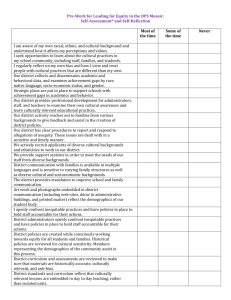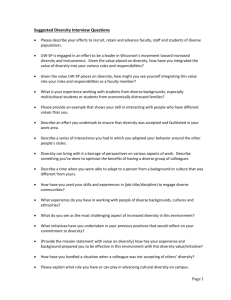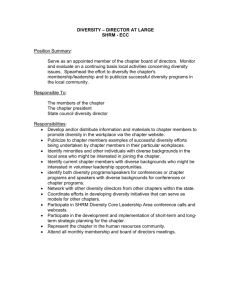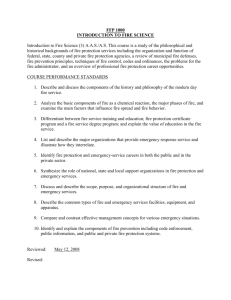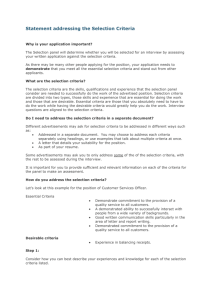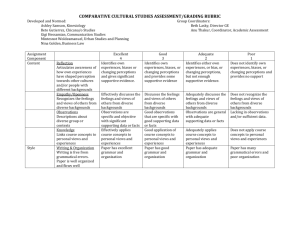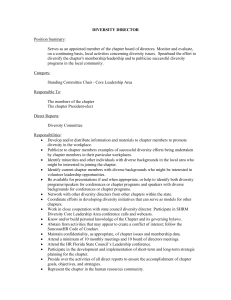OTS501_I_Intro and Background_2015
advertisement
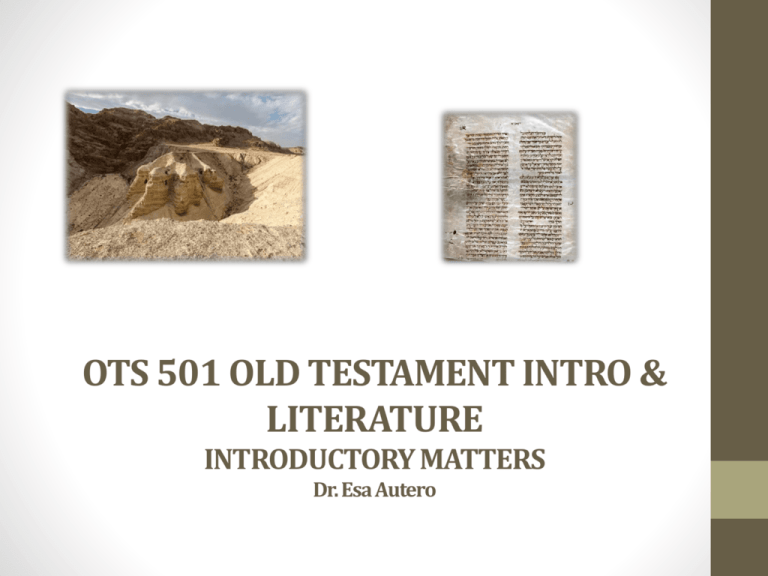
OTS 501 OLD TESTAMENT INTRO & LITERATURE INTRODUCTORY MATTERS Dr. Esa Autero Introduction and Backgrounds 1.1 Introduction • Why study the Old Testament? • The Bible Jesus and the apostles used • Provides essential background for understanding the NT • Explicit quotes, allusions, symbols, institutions etc. • Classic of the western civilization • History, politics, arts • Teaches about God and His character and attributes • Creation – history – prophecy • Christian & Jewish communities Introduction and Backgrounds Test your knowledge about OT 1. How many books are included into the Hebrew OT canon? 2. In what two languages were the OT originally written? 3. What is the name of God in Gen 1 and Gen 2? 4. After which king does the kingdom split into north and south? 5. Name three main empires that Israel had to contend with 6. What does Tanakh stand for? 7. What is the most important saving event of the OT? 8. Who wrote the book of kings according to tradition? 9. What is Deuteronomistic history? 10. What are the following: decalogue, the priestly blessing, and shema? Introduction and Backgrounds Common popular misunderstandings about OT • OT God is the God of judgment and NT of love • OT is irrelevant and outmoded to modern believers • Jewish people were saved by obeying the 613 OT Laws • Archaeology has proven that OT is historically accurate • Archaeology has proven that OT is historically inaccurate • Leviticus has no relevance to modern Christians • OT God is mischievous and bloodthirsty • There is no need to study or read the OT – NT is enough Introduction and Backgrounds • What is the Old Testament? • Old Testament or Hebrew Bible? • Who’s Bible? • What’s included in the OT and why? • The three-fold division of Hebrew Tanakh (35 books [24 books*]) • Protestant OT (39 books) Correspond to Masoretic Text (MT) • Catholic OT (+10 Apocrypha) • Orthodox OT (+15 Apocrypha) Correspond to Vulgate and Septuagint (LXX) • Protestants follow Jewish tradition Introduction and Backgrounds 1.2 OT and hermeneutics • Interpretation and use of OT in history • Annihilation of indigenous peoples of the Americas “Oíd, hijos: dice la Sagrada Escritura que cuando los judíos adoraron al becerro mandó Moisés, que era su caudillo, a los levitas que matasen a todos los que habían adorado la huaca [ancient burial place] y, sin reparar que eran sus hermanos y parientes, mataron de una vez 23 mil hombres: ¿qué dices a esto, indio? Si Dios mandara matar a todos los indios que han adorado la huaca en el Perú ¿quién quedará con vida?» (From the sermon of Hernando de Avendaño” [16th century] in RIBLA 11) • Bartolomeo de las Casas: biblical principles of love and mercy Introduction and Backgrounds • Joshua narrative & the annihilation of ‘Canaanites’ • Native Americans • The curse of Ham (Gen 9:20-27) and blacks • More positive examples of socio-political interpretation The central feature of the account for the tribes of Israel was the part played by Yahweh in their liberation. They did not read the exodus as a secular revolutionary movement. Yahweh was on their side and guided the movement through his prophet Moses. The fact that they succeeded in escaping from their enforced serfdom despite the powerful Egyptian army showed that God, who took the side of the poor in Egypt, was the true God (Pixley and Boff 1995: 213*) • Life transforming power of the Bible • Basis for western civilization Introduction and Backgrounds OT in recent interpretation – some issues and problems • Listen to the text vs. reading my own ideas into the text • Historicity & the problem of minimalism • Various reading strategies • • • • • Historical-critical approach Evangelical approach(es) Literary approaches Liberationist and socio-political approaches Postcolonial criticism Introduction and Backgrounds 1.3 Formation of OT canon – a brief outline Basis in Heb 1:1 OT records utterances that claim divine authority God & Moses Ex 20, 24 “Thus says the LORD” in the prophets Some of the utterances were written down: 10 commandments & Book of the covenant Ex 31:18, 24:7 Prophetic texts: Jeremiah and Baruch Jer 36:32 Introduction and Backgrounds Intra-canonical witness The Pentateuch • • • • Recognized first (Josh 1:8; 24:26) 10 commandments placed into the ark of the covenant Josiah’s reform & ‘book of the Law’ 2 Kgs 22:8 (640-609 BC) Law as normative for the people (Ezra 9-10; Neh 8-10) Editorial processes (e.g. Deut 34; Josh 24:26) The prophetic and historical writings • Daniel recognizes prophet Jeremiah and ‘the books’ 9:2 • Jeremiah recognizes Micah’s prophecy in Jer 26:18 (written 150 yrs. later) • The chain of prophetic history from David to end of Judah (1 Chr 29:29; 2 Chr 9:29, 12:15, 13:22, 20:34, 32:32, 33:18-19) • E.g. Seers (Isaiah?) wrote the history of Hezekiah (2 Chr 33:18-19) Progressive recognition of the inspired writings as Scripture Introduction and Backgrounds The Formation the Canon of OT (External witnesses) • Three groups of OT: Law, Prophets, and Writings • Ben Sirach’s prologue in 132 BC (and Sir 49:8-10; 44-50) • 2 Macc 2:13 (104-63 BC): Judas’ collection of sacred writings • Dead Sea Scrolls – all but Esther* • Some ambiguities on additional books (e.g. Book of Jubilees) • Philo of Alexandria (c. AD 50) – “Laws and oracles given by inspiration through the prophets and psalms” (Vita Cont. 25) • Josephus (CA 1.37-43): Scripture ‘no-one altered a syllable…’ Introduction and Backgrounds For we have not an innumerable multitude of books among us, disagreeing from and contradicting one another, [as the Greeks have,] but only twenty-two books, which contain the records of all the past times; which are justly believed to be divine; and of them five belong to Moses, which contain his laws and the traditions of the origin of mankind till his death. This interval of time was little short of three thousand years; but as to the time from the death of Moses till the reign of Artaxerxes king of Persia, who reigned after Xerxes, the prophets, who were after Moses, wrote down what was done in their times in thirteen books. The remaining four books contain hymns to God, and precepts for the conduct of human life…and how firmly we have given credit to these books of our own nation is evident by what we do; for during so many ages as have already passed, no one has been so bold as either to add any thing to them, to take any thing from them, or to make any change in them; but it is become natural to all Jews immediately, and from their very birth, to esteem these books to contain Divine doctrines, and to persist in them, and, if occasion be willingly to die for them. (Josephus, Against Apion 1:8) Introduction and Backgrounds • OT in the New Testament: • Jesus quoted and referred as authoritative (Jh 5:39, Mt 23:35) • Apostles quote authoritatively (Rom 9:25-26) • OT canon was written by 400-350 BC • Progressively recognized from the time of Joshua • Law-prophets-writings • Over a time span of about one millennium • OT canon – toward finalizing the process* • Pentateuch – in the period of Ezra (Ezra 7:10, 14, 26; Neh 8:1-2) • Prophets and writings a bit later (cf. previous slides) • “Council” of Jamnia AD 90 (Ecclesiastes & Song of Songs discussed) • OT canon fixed prior to Jamnia – catalyzed by AD 70[?] • Easter Letter of Athanasius AD 367** • Councils of Hippo and Carthage AD 393 and 397AD Introduction and Backgrounds • The Preservation of the OT • No original manuscripts exist • Silver Scroll - Earliest piece of OT: Num 6:24-26 (app. 650 BC) Is our current OT same as the one Jesus read? Introduction and Backgrounds OT Textual Traditions - A Quick Guide: i.) The Masoretic Text (MT) • Masoretes and the textual tradition (AD 500-900) • Vowel points and standardization of the text • Oldest complete manuscript Leningrad Codex 1008 AD • Aleppo Codex (AD 900) & Cairo Codex (AD 896 [Prophets]) • Accuracy of Isaiah & Dead Sea Scrolls (1QIsaa) ii) The Samaritan Pentateuch (pre-Samaritan version [100 BC-AD 100]) • Exile in 722 BC and the mixing of Jews* • Scribal changes to the text • • • • • Mt. Gerizim instead of Sinai “place…the Lord will choose” vs. “place…has chosen” (Deut 12:5) 11th commandment – building altar on Mt. Gerizim Textual expansions & harmonization Resistance to anthropomorphisms • Agrees w/ LXX against MT in app. 2000 instances Introduction and Backgrounds iii) Septuagint (LXX)* • Greek translation of the Hebrew text (250-c.150 BC) • Number of variations against MT (agrees with DSS in part) • E.g. Jeremiah & Job** • Mostly used by NT authors in OT quotations iv) Dead Sea Scrolls (DSS) • Found 1947 from Khirbet Qumran • Over 200 biblical manuscripts • Proto-MT; 4QpaleoExod^ [pre-Samaritan]; LXX-type; unknown • Manuscripts from all OT books but Esther • The general accuracy of MT textual tradition of Isaiah (http://dss.collections.imj.org.il/isaiah_video) & fluidity of text OT Textual versions Texts to Babylon c. 587 BC Proto-MT 4th century BC Pre-Exilic writings of OT Old Palestinian recension, 5th BC? Proto-Sam. recension, 4th BC* Hb. proto LXX, 4th BC Samaritan recension, 1st BC LXX, 250150BC Various recensions used side by side MT, AD 5001000 Standardization from 100BC- LXX versions, 100BC-200AD Today’s Old Testament based on textual criticism Introduction and Backgrounds 1 Sam 10:26-11:1 [NIV] 26 Saul also went to his home in Gibeah, accompanied by valiant men whose hearts God had touched. 27 But some scoundrels said, “How can this fellow save us?” They despised him and brought him no gifts. But Saul kept silent. 11:1 Nahash the Ammonite went up and besieged Jabesh Gilead. And all the men of Jabesh said to him, “Make a treaty with us, and we will be subject to you.” 1 Sam 10:26-11:1 [NRSV] 26 Saul also went to his home at Gibeah, and with him went warriors whose hearts God had touched. 27 But some worthless fellows said, “How can this man save us?” They despised him and brought him no present. But he held his peace. Now Nahash, king of the Ammonites, had been grievously oppressing the Gadites and the Reubenites. He would gouge out the right eye of each of them and would not grant Israel a deliverer. No one was left of the Israelites across the Jordan whose right eye Nahash, king of the Ammonites, had not gouged out. But there were seven thousand men who had escaped from the Ammonites and had entered Jabesh-gilead. 11:1 About a month later, Nahash the Ammonite went up and besieged Jabeshgilead; and all the men of Jabesh said to Nahash, “Make a treaty with us, and we will serve you.” Introduction and Backgrounds Conclusion: • Fluidity of the OT/HB text in the late 2nd Temple • Toward standardization from the 100BC • In most cases the original reading can be reconstructed by using the sources we have • “over 90% of the Old Testament is textually sound and uniformly witnessed to by the major exemplars. Of the remaining 10 percent of the text that exhibits any form of variation, extremely few are of such significance that they would involve any major doctrinal issue.” Prof. B. Waltke • Jesus and the apostles considered OT writings as authority and only quoted them as Scripture Introduction and Backgrounds 2.1 OT in Historical and Cultural Context • OT and its relationship to the history of ANE • OT and the Ancient Near East • OT did not drop from heaven • Part of ANE culture and history • The Fertile Crescent • • • • • Mesopotamia Egypt Asia Minor/Anatolia Syria-Phoenicia Palestine Intro and Background • K Introduction and Backgrounds • Mesopotamia • The Sumerians (3000-2000 BC) • City-states of lower Mesopotamia • Cities of Ur, Lagash, Uruk • Earliest writing system (cuneiform [c. 3200BC]) & counting by 60s • First law codes; schools; writing; ziggurats (cf. Gen 10) • The Akkadians (2350-2060 BC) • 1st empire by Sargon I • Semitic people • The Amorites (2000-1500 BC; Ezek 16:3) • • • • • Semi-nomadic tribesmen from Arabia Established Mari and Babylonia Mari tablets bear similarities to patriarchal customs Hammurabi’s law code Conquered by the Hurrians (Horites in OT) Introduction and Backgrounds • Aramean and Habiru (1500-1000 BC) • Seminomadic wanderers from Arabia • Social class of slaves, outlaws, hired soldiers, migrants, wanderers • Hebrews part of the Habiru group but not identical with it • Asia Minor & Hittites (2000-1400 BC) • The Hittite empire “sons of Heth” (Gen 10:15) • Sarah’s burial site & Esau’s Hittite wives (Gen 23:2; 26:34) • Threat to Egyptian kingdom app. 1400 BC Introduction and Backgrounds • Egypt – the land of the Nile & Pharaohs • The building of the great pyramids in the Old Kingdom (2500 BC) • Abraham goes to Egypt due to famine (Gen 12:10-20) • The Hyksos rule Egypt (1720-1570 BC) • First to use chariots and cavalry • Hyksos overthrown by 18th dynasty (Ahmose I) • Egypt controlled Palestine until late 1200s BC • Ramses II (1290-1224 BC) & Exodus (late date)* • Amenophis II (1450-1425 BC) & Exodus (early date) • Syria-Phoenicia • Syria - to the north and east of Palestine • Challenged Sargon’s empire in the early 2000s BC • Ebla flourished (2000-1600 BC) – cf. Ebla tablets • Phoenicia – northwest of Palestine • Major Canaanite stronghold • Seafarers & source of wood for Solomon’s temple & palace Introduction and Backgrounds • Palestine – the “Holy Land” • Importance in ANE as a “bridge” and “buffer” • Four major geographical areas • The coastal plain – narrow strip of land on the Mediterranean coast • Philistines in the south: Gaza, Ashdod, Ashkelon, Ekron & Gath • Plain of Sharon – Mt. Carmel – Plain of Acco/Acre – Ladder of Tyre • Phoenician territory: Tyre and Sidon to the north • The central hill country – the central ‘backbone’ • • • • • The core Hebrew territory Upper and lower Galilee hills (from 2000 to 3000 ft.) Plain of Megiddo & Jezreel valley Southern hills become higher – intruding W-E valleys Hill country of Judah to Negev in the south to Sinai desert Introduction and Backgrounds • The Jordan Rift – the ‘scar’ in the earth • Base of Mt. Hermon through Palestine to East Africa • Jordan river and Sea of Galilee (and Lake Huleh) • Lake Galilee is 600ft below sea level to Dead Sea (1290ft. below) • The Transjordan plateau • East of Jordan river • Biblical Gilead & Bashan • Ideal cattle and sheep country • • • • Region of the Moabiates and Ammonites (cf. Gen 19:37-38) Jabbok river & the wrestling Jacob (Gen 32:22-32) Area of Rueben, Gad, and Manasseh Constant disputes w/ Syrians Introduction and Backgrounds • How big was/is the Jordan river? On Jordan’s stormy banks I stand, And cast a wishful eye To Canaan’s fair and happy land, Where my possessions lie. Filled with delight my raptured soul Would here no longer stay; Though Jordan’s waves around me roll, Fearless I’d launch away. (On Jordan’s Stormy Banks I Stand by S. Stennett) • What is the hymn’s depiction of Jordan? In reality only app. 10ft. (3m) wide Intro and Background Introduction and Backgrounds Important roads • The Way of the Sea • From Egypt along the coast through Philistine to Mesopotamia • The Kings highway • From Egypt to Damascus (north-south) • Power and money – control of the trade routes • Smaller east-west roads • Strategic connections of cities • Plain of Acre through Megiddo – Jezreel valley to Jordan Intro and Background • K Introduction and Backgrounds 2.2 Land of Israel – Theology & Imagery • Important theological symbol • Promise to Abraham (Gen 12:1-3) • Promised Land as a covenant blessing • “good and spacious…flowing…milk and honey” (Ex 3:8) • Removal of the Canaanites due to wickedness (Lev 18:24-30) • Exile as the covenant curse (Deut 27-28) • YHWH Lord of the whole world (Ps 24:1; Isa 66:1) • God’s presence even in Exile (Ezek 1) • “Exiled” while in the Land (Neh 9:32-37) Introduction and Backgrounds • Language and imagery reflecting geography (Ps 1; 23; Dt 32:15) I lift up my eyes to the hills— from where will my help come? 2 My help comes from the LORD, who made heaven and earth. Ps 121:1-2 Save me from the mouth of the lion! From the horns of the wild oxen you have rescued me (Ps 22:21) O God, you are my God, I seek you, my soul thirsts for you; my flesh faints for you, as in a dry and weary land where there is no water (Ps 63:1) Introduction and Backgrounds 3.1 OT Story-line in a nutshell • Creation • Flood • Patriarchs • Move to Egypt & Sojourn in Egypt • Exodus and wilderness wandering • Conquest • Judges • United monarchy • Divided monarchy • Prophets • Exile and fall of Jerusalem • Return from Exile Introduction and Backgrounds • K

